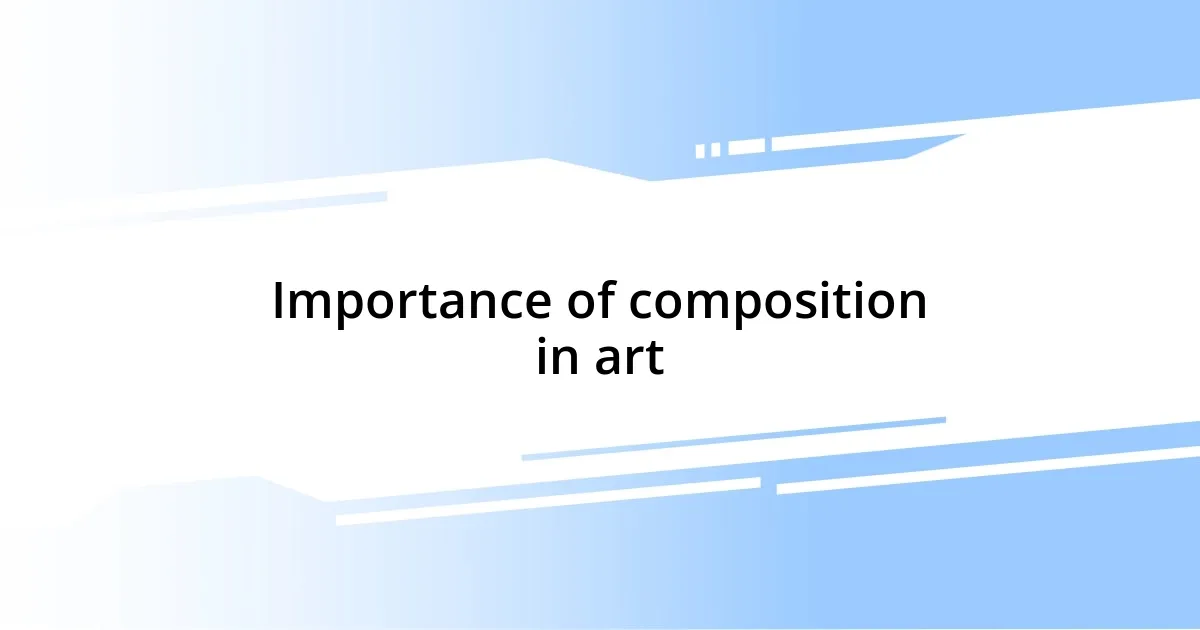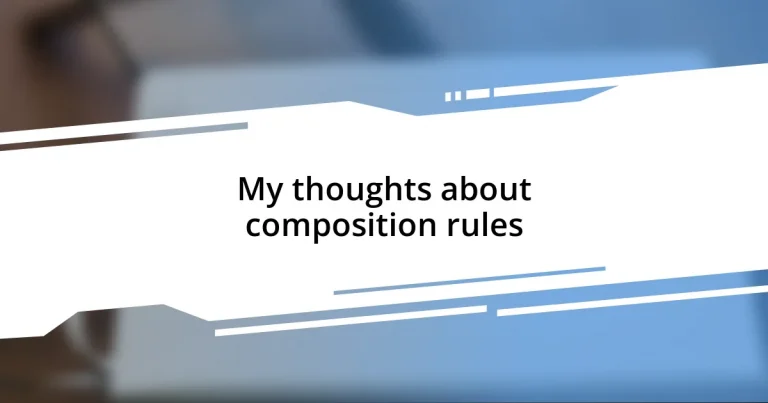Key takeaways:
- Composition enhances visual storytelling and emotional engagement in art, allowing viewers to connect deeply with the work.
- Key principles such as the rule of thirds, balance, leading lines, and contrast are essential tools for artists to create impactful compositions.
- Applying composition rules creatively, including experimenting with negative space and focal points, can lead to innovative and unexpected results.
- Learning from various art forms, maintaining a sketchbook, and seeking feedback are effective strategies for improving composition skills.

Understanding composition rules
Understanding composition rules truly starts with recognizing their purpose in enhancing visual storytelling. Think about the last time you were drawn to a photograph or a piece of art—chances are, it wasn’t just the subject that caught your attention but how it was framed. For instance, I once attended a photography workshop where the instructor emphasized the rule of thirds; it completely transformed how I viewed composition.
When I first learned about leading lines, I was amazed at how they can guide the viewer’s gaze through an image. It reminded me of a time I wandered through a tree-lined path, enchanted by how the branches seemed to lead me into a painting. Isn’t it fascinating how these seemingly simple rules can profoundly impact our perception of balance and harmony in art?
Furthermore, understanding composition rules is not about rigidly adhering to them, but rather about knowing when to break them for creative expression. Isn’t it liberating to think that sometimes straying from the norm can lead to the most striking results? I remember the excitement I felt when I experimented with asymmetry in my own visual projects, and how it opened up a whole new world of creativity for me.

Importance of composition in art
Composition plays a pivotal role in art, acting as the backbone that supports visual narratives. I’ve seen firsthand how a well-thought-out composition can amplify emotion and meaning. For instance, during a community art exhibit, I was captivated by a painting that used negative space effectively. The empty areas around the subject created a sense of isolation, pulling me deeper into the artist’s intent and evoking feelings of loneliness that stayed with me long after I left.
- Composition shapes viewer engagement, drawing people into the artwork.
- It influences the emotional response, making connections feel more profound.
- Understanding composition rules helps artists convey messages clearly and powerfully.
Art’s composition can also prompt unexpected revelations. I remember working on a collage and instinctively placing elements that didn’t adhere to traditional rules. Surprisingly, that choice led to a striking balance that made the artwork feel alive, inviting discussion and interpretations I hadn’t anticipated. It’s those moments when creativity breaks free that truly illuminate the importance of composition in expressing our unique perspectives.

Key principles of composition
Understanding the key principles of composition is essential for any artist or photographer. For instance, when I first experimented with the golden ratio in my artwork, it was like unlocking a secret that naturally drew the viewer’s eye to the focal point without overpowering the rest of the piece. It’s remarkable how such mathematical concepts can breathe life into art.
Another principle I find incredibly compelling is balance. I remember creating a piece where I intentionally placed heavier objects on one side with lighter elements on the opposite. This contrast not only created tension but also sparked conversations among viewers about the choices I made. It highlighted how composition can evoke emotional responses and foster dialogue.
Lastly, contrast is a principle that I always try to incorporate into my work. The interplay between light and dark, or vibrant colors against muted tones, can bring energy and depth to an image. I once took a photograph using a subject with bold colors against a subdued background. The vibrancy of the subject leaped out, and it was exhilarating to see how it transformed the mood of the composition.
| Principle | Description |
|---|---|
| Rule of Thirds | Divides an image into thirds for more dynamic framing. |
| Leading Lines | Draws the viewer’s eye along a path within the composition. |
| Balance | Creates visual stability through the arrangement of elements. |
| Contrast | Enhances depth and interest through opposing colors or tones. |
| Negative Space | Utilizes blank areas to emphasize the main subject and convey mood. |

Analyzing balance in composition
When I analyze balance in composition, I often consider how each element interacts with others to create harmony or tension. I recall a sculpture I once created, where I played with asymmetry. By placing a larger form on one side and delicate, intricate pieces on the other, I saw how balance doesn’t always mean symmetry. This choice generated curiosity and kept viewers engaged, prompting them to explore the piece far longer than they might have if it were more conventionally balanced.
Have you ever thought about how the placement of colors affects the visual weight of a composition? I’ve experimented with this quite a bit in my paintings. Once, I used deep, dark colors on one side, contrasting them with lighter, pastel shades on the opposite end. This arrangement created a striking tug-of-war that made the entire composition come alive. The viewer’s gaze naturally oscillated between the two, creating a sense of movement and drawing them deeper into the narrative.
Balance can evoke a range of emotional responses that resonate with viewers. I witnessed this firsthand during a photography exhibit where one image stood out, featuring a small, solitary figure against a sprawling landscape. The overwhelming space around the figure created a beautiful tension, making the viewer ponder feelings of insignificance and solitude. It made me realize that thoughtful balance in composition isn’t just about aesthetics; it’s about crafting experiences that linger in the hearts and minds of those who engage with the art.

Exploring contrast and harmony
When I think about contrast and harmony in art, I often reflect on the magic that unfolds when opposites collide. I remember a project where I used a bright yellow against a deep blue background. The intensity of the yellow practically hummed with energy while the blue grounded it, creating an exhilarating interplay that still resonates with me today. Have you ever noticed how such contrasts can evoke unexpected emotions? It’s like a dance where each color has its own role, but together, they create something truly dynamic.
Exploring harmony through contrast can be illuminating. For instance, I once embarked on creating a series of black-and-white photographs. The lack of color forced me to explore textures and shapes more deeply. As I captured the stark contrasts between light and dark, I discovered a new sense of harmony in the forms themselves. It dawned on me that sometimes, the absence of color can actually amplify the visual narrative, leading to a profound connection with the viewer. Isn’t it fascinating how constraints can often lead to creative breakthroughs?
I’ve found that contrasting elements don’t just coexist; they enhance the experience of the whole piece. During a collaborative mural project, we decided to incorporate a mix of soft pastels alongside bold, aggressive strokes. This unexpected combination not only held attention but sparked conversations among the viewers, creating a communal experience. The contrast evoked a mix of feelings—joy from the pastels and intensity from the bold colors—showing me that harmony doesn’t only arise from similar elements but can thrive through the vibrancy of difference. What have you experienced in your own artistic journey that echoes this idea?

Applying composition rules in practice
Applying composition rules in practice requires a delicate touch that blends intuition with learned techniques. I remember the first time I used the rule of thirds while photographing landscapes. By placing the horizon along the top third of the frame, the foreground came alive, leading the eye through the lush grass and up to the sky. Those simple adjustments transformed an ordinary shot into something breathtaking. Have you ever experimented with this rule? It might just open new avenues in your work.
Creating focal points is another essential aspect I’ve learned. In a recent painting, I used a splash of red in an otherwise muted palette. This vibrant pop drew attention immediately, steering viewers’ thoughts and emotions toward the intended message. I noticed how people lingered longer in front of this piece, their reactions shifting as they connected emotionally with the story behind the colors. Isn’t it intriguing how a single element can impact an entire composition so profoundly?
Lastly, I often find myself pondering the use of negative space. In a series of abstract pieces, I deliberately left large areas blank, allowing the viewer’s imagination to fill in the gaps. This choice made the existing shapes more powerful and engaging. I was surprised to see how many different interpretations emerged from such simplicity. Have you ever embraced negative space in your art? It’s a daring move that can lead to unexpected depths and resonate on a personal level with your audience.

Tips for improving composition skills
One effective tip for improving your composition skills is to constantly analyze and learn from various art forms. I remember attending a gallery where I was captivated by how a sculptor manipulated space and shape. It sparked a realization in me: even in my two-dimensional canvases, I could borrow those principles of three-dimensionality. Have you ever looked at a different medium and found inspiration that directly influenced your style? It’s amazing how stepping outside our usual boundaries can lead to explosive creativity.
Another approach lies in keeping a sketchbook to jot down quick ideas and compositions. When I began this practice, I found myself exploring unconventional angles and arrangements that I wouldn’t typically consider. One evening, while sketching an alleyway scene, I playfully tilted the angle to create a sense of movement, and this simple change transformed the entire feel of the piece. How freeing is it to experiment without the fear of judgment? It can bring a liberating sense of spontaneity to your composition process.
Lastly, don’t underestimate the power of feedback from fellow artists or friends. I once showed a draft of a painting to a peer, and their suggestion to emphasize shadows completely shifted my perspective. Their fresh viewpoint illuminated areas I hadn’t realized needed more depth. Have you ever experienced a moment where someone’s critique altered your work for the better? Engaging in open discussions can uncover invaluable insights that enrich your artistic voice and strengthen your compositions.












